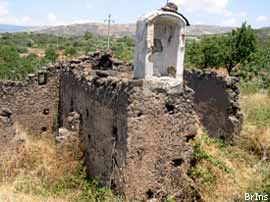The Norman Kings gave a big impulse to all the productive activities of the island, supported the commercial exchanges and protected the studies and the arts. Under the Norman kings the territory in Bronte, Maletto, Corvo, Ròtolo, Santa Venera, as far as Randazzo, was not part of the state property, but prerogative of the queen ("dotario"). The town enlarged itself extending up to San Vito, towards the hills Colla and San Marco, and the SS Maria of the Rosary church, becoming a true and real little city. About at the year 1174, for express wish of the queen mother, Margherita of Navarra, the king Guglielmo II (the good one) had, on the ruins of the Basilian hermitage containing the icon of the Virgin With The Child, founded about 1040 by the Byzantine Giorgio Maniace, a Benedictine monastery built under the title of Santa Maria Of Maniace. The monastery, with diploma of March 1st, 1174, depended from the Messina Diocese and, in 1178, from Monreale. Guglielmo II died in 1189 without leaving heirs therefore to the Svevi was offered the opportunity to take possession of the island. Having become masters of the island, they governed from 1194 to 1268, especially with Federico II, very cultured and definite man of open intelligence, "the first modern sovereign of Europe" and best king of Sicily that he used to call "pupil of my eyes". Their successors were the Angioini until 1282 and, finally, the Aragonesi from 1296 to 1516, able only to get rich at the already poor population's expense.
The Albanians
The emigration from Sicily, which will become like an incurable sore in the body of the island's population, did not begin until the middle of 1400. Strangely in that period our island became the "promised land" of another people:the Albanians, the only people which did not come to conquer it and dominate it but to find their refuge, work and well-being. With the conquest by the Turkish and Ottoman part of Constantinople, ancient Byzantium, in the 15th century, only the Albanians were resisting to the invasion, so becoming the last bulwark of Christendom in Europe, being of Greek-Catholic rite. After the death of Giorgio Castriota (nicknamed Skanderbeg) the exodus from Albania, begun in dribs and drabs around 1448, got more solid and, starting from 1468 to 1491, above all towards Sicily, where the feudatories, having increased the grain price, were encouraging colonization. Also Bronte accepted in that period a large representation of Albanian citizens'. Most of them were coming from the Morea and in Sicily they found an adoptive country as they populated empty farmhouses because of wars, earthquakes and plagues.
The "foundation" of Biancavilla dates from 1488 like that of Bronte which should have happened shortly after as the "Capitoli di fondazione", (foundation chapters), were lost and the exact date is not known. In these "Chapters" can be felt a certain benevolence, by the feudatories and/or clergymen. The Albanians, in fact, were enjoying a certain freedom: they could move from a site to another; sell its possessions; have its own officers and priests; did not have to submit to oppressions. Of the uses and customs or the Albanian religion very little has remained in our territory; only some surname is indicative of Albanian origin (Scafiti, Schiros, Schilirò, Triscari, Zappia), and many typical words of sure Albanian origin. Benedetto Radice (Historical Memories of Bronte) writes that in Bronte there was also a church, Santa Maria della Scala, dedicated to the Patroness of the Albanian colonies, Santa Maria dell'Odigitria. The ruins of this church (it was the church of the Casale di Santa Maria della Scala in the district Scalavecchia) are still visible next to the Provincial Road 211 (Bronte-Ponte Passopaglia). The Radice also states that it was also called "S. Maria dell'Odigitria, patron of the Albanian colonies", which is "placed in the hills near the Piana", and "of which the walls of a rectory and sacristy still exist". |